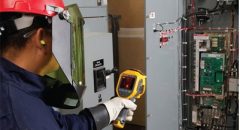Arc Flash Study & Arc Flash Hazard
Arc flash accidents can cause serious injuries and equipment damage. An arc flash study helps you find risks, set safe limits, and stay compliant with NFPA 70E and IEEE 1584 standards.
What is an Arc Flash Hazard?
Definition and Mechanism
An arc flash happens when electricity jumps through the air between two points, releasing extreme heat and pressure. It usually occurs when insulation fails or current flows through the wrong path.
Typical Causes of the Hazard
Common causes include loose connections, dust, moisture, worn-out equipment, or dropped tools. Even small mistakes during maintenance can start an arc flash.
Consequences and Severity
Arc flashes can reach over 35,000°F, hotter than the sun’s surface, causing burns, hearing loss, and major equipment damage. The pressure wave and flying debris can also injure anyone nearby.
Why Conduct an Arc Flash Study?
Risk Identification and Quantification
The study measures how powerful a flash could be and how far it could spread, helping you focus protection where it’s needed most.
Regulatory Compliance and Legal Obligations
NFPA 70E and OSHA require identifying and controlling arc flash hazards. Conducting a study keeps you compliant and helps avoid costly penalties.
Protection of Personnel and Assets
Understanding hazard zones keeps workers safe, prevents downtime, and helps protect your equipment from damage.
What are Core Components of an Arc Flash Study?
Data Collection and System Modelling
Engineers gather key details—like one-line diagrams, cable sizes, and breaker settings—to build an accurate system model. Good data equals reliable results.
Short-Circuit and Coordination Analysis
Short-circuit and coordination studies show how faults move through your system and how protection devices respond. These are essential steps in arc flash analysis.
Incident Energy and Boundary Calculations
Using IEEE 1584 standards, engineers calculate energy levels and define safe working distances (arc flash boundaries) for each point in your system.
Interpreting Study Results & Labels
Understanding Incident Energy Values
Incident energy tells how much heat a worker could be exposed to during a flash. PPE ratings are matched to these values for proper protection.
Arc Flash Boundary and PPE Requirement
The arc flash boundary shows how close someone can safely work without PPE. Inside this area, workers must wear arc-rated protective gear.
Equipment Labeling and Documentation
Each electrical panel should have an updated label showing hazard levels, PPE category, and safe distance. Clear labeling keeps everyone informed and safe.
What are Mitigation Strategies and Best Practices
Engineering Controls & Electrical Design Changes
Design updates—like arc-resistant switchgear, fast-acting relays, or high-resistance grounding—can significantly lower incident energy levels.
Administrative Controls and Safe Work Practices
Use safe work procedures such as de-energizing before maintenance, remote operation, and proper signage. Training ensures these rules are followed.
Personal Protective Equipment (PPE)
Workers must wear the right PPE—arc-rated clothing, gloves, helmets, and shields—based on the calculated hazard levels.
What are the Challenges and Common Pitfalls in Arc Flash Studies
Incorrect Source or Faulty Data
Wrong utility or equipment data leads to inaccurate results. Always confirm system details before analysis.
Outdated or Incomplete System Modelling
If your system diagram is old or incomplete, your study results may not match real conditions.
Lack of Updates and Maintenance
After equipment upgrades or layout changes, update your arc flash study and labels to stay compliant and safe.
Implementing and Maintaining a Robust Arc Flash Safety Program
Training and Qualification of Personnel
Train electricians and operators to recognize hazards, understand labels, and use PPE correctly.
Periodic Review and Re-Assessment
Review your arc flash study every 3–5 years or after system changes. Keeping it current ensures accuracy and safety.
Integration with Overall Electrical Safety Management
Include arc flash procedures in your broader safety plan—covering lockout/tagout, maintenance, and emergency response protocols.
Conclusion:
An arc flash study is one of the best ways to protect your people and equipment. With proper analysis, safe design, and regular training, your organization can greatly reduce risk and meet all major electrical safety standards.
Ready to Improve Your Electrical Safety?
Protect your team and ensure compliance today.
Contact our experts to schedule a professional Arc Flash Study or safety assessment.
Let’s build a safer, smarter, and more compliant electrical system together.
Get free a quote
Submit your Details
+91 99994 02106
What we offer
Our Services
Identify, evaluate, and control process hazards with expert risk assessments, ensuring safe, reliable, and compliant industrial operations.

Identify, evaluate, and control process hazards with expert risk assessments, ensuring safe, reliable, and compliant industrial operations.

Implement site safety plans, audits, and training to prevent accidents, ensuring safer construction environments and regulatory compliance.

Design, engineer, and audit fire protection systems ensuring reliable performance, asset safety, and adherence to national safety standards.

Empowering workforce with certified HSE, fire, and industrial safety training programs for skill development and regulatory competence.

Create immersive, interactive VR safety training modules for realistic learning experiences in hazard recognition and emergency preparedness.
How it works
Industry Consultation
Project Scoping & Industry Brief
Service Selection
Site Visit & Inspection
Audit & Analysis
Report Submission & Discussion
Frequently Ask Question
Arc flash studies should be reviewed and updated every 3 to 5 years, or sooner if there are system modifications, such as equipment replacements, load changes, or protection setting adjustments. Regular updates ensure the study remains accurate and compliant with NFPA 70E and OSHA requirements.
You’ll need accurate electrical system data, including one-line diagrams, transformer and cable details, breaker settings, and protective device information. Reliable data collection is essential for precise modeling and hazard calculations.
Any facility operating electrical equipment over 50 volts must comply with NFPA 70E and OSHA 1910 Subpart S regulations. This includes industrial plants, commercial buildings, data centers, and utilities.
The required Personal Protective Equipment (PPE) depends on the incident energy level at each work location. PPE categories range from basic arc-rated clothing and face shields to full flash suits with gloves and hoods for higher energy exposures.
A properly conducted study helps:
Identify and mitigate hazards before incidents occur.
Ensure compliance with OSHA and NFPA 70E standards.
Protect personnel and equipment from severe damage.
Reduce downtime and improve overall system reliability.
